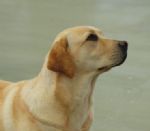HISTORY OF THE BREED
Breed History

Labrador Retrievers were originally found, not in Labrador, but in Newfoundland, where they were used in many capacities by cod fisherman. With their short but exceptionally dense coat, they were well suited to the cope with the freezing salt spray, snowy and icy near-Arctic winds, and with their willingness to help and please which persists to this day, they have been the most useful helpers.
They were expected to retrieve the fish that slipped out of the net and flapped on the icy surface of the sea. They had to carry the rope end from the boat to the shore in the strongest of tides and stormiest weather. They were strongly built so that they could pull a heavy sled carrying firewood, barrels of fish, and other necessities of life in a place where horses would be useless.
They had to survive and indeed thrive and breed, on the scantiest of food, probably half frozen fish guts, a piece of dried meat, and a surreptitious chew at their leather harness. All these activities took place in terrible weather conditions, needing the dense waterproof coat of the Labrador Retriever. As the work was done in water and on land, in forests, snow drifts and over slippery rocks, an extremely active, well made and balanced dog was required without any structural weakness in its frame and free from exaggeration anywhere.
In the early 1880's, in the north of England, a few landowners mated together a handful of Labradors that had survived from an earlier importation. These land owners were quick to realise the value of the dogs as a sporting and working dog, and a breeding strain was soon established.
In 1916 the Labrador Club (Eng) was formed to ensure purity of the breed, and it was they who drew up the standard.
They were expected to retrieve the fish that slipped out of the net and flapped on the icy surface of the sea. They had to carry the rope end from the boat to the shore in the strongest of tides and stormiest weather. They were strongly built so that they could pull a heavy sled carrying firewood, barrels of fish, and other necessities of life in a place where horses would be useless.
They had to survive and indeed thrive and breed, on the scantiest of food, probably half frozen fish guts, a piece of dried meat, and a surreptitious chew at their leather harness. All these activities took place in terrible weather conditions, needing the dense waterproof coat of the Labrador Retriever. As the work was done in water and on land, in forests, snow drifts and over slippery rocks, an extremely active, well made and balanced dog was required without any structural weakness in its frame and free from exaggeration anywhere.
In the early 1880's, in the north of England, a few landowners mated together a handful of Labradors that had survived from an earlier importation. These land owners were quick to realise the value of the dogs as a sporting and working dog, and a breeding strain was soon established.
In 1916 the Labrador Club (Eng) was formed to ensure purity of the breed, and it was they who drew up the standard.
Contact Details
Linda AdamsLabertouche, VIC, Australia
Phone : 0403342637
Email : [email protected]
